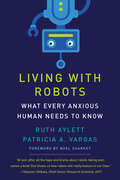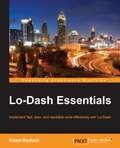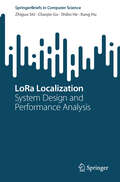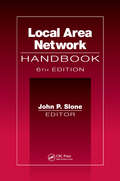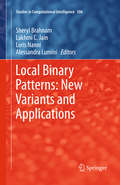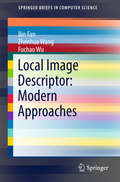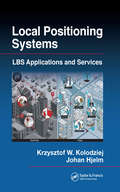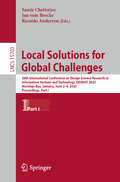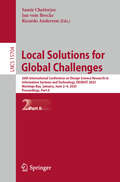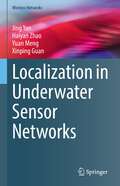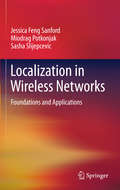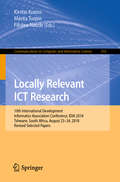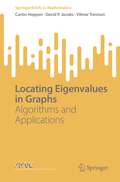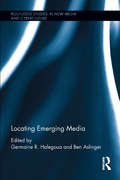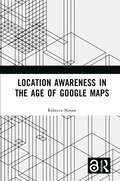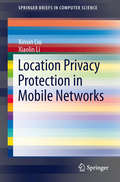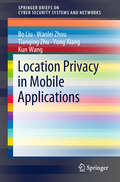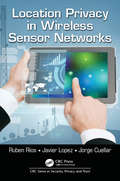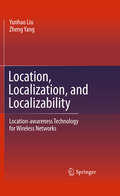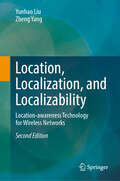- Table View
- List View
Living with Monsters? Social Implications of Algorithmic Phenomena, Hybrid Agency, and the Performativity of Technology: IFIP WG 8.2 Working Conference on the Interaction of Information Systems and the Organization, IS&O 2018, San Francisco, CA, USA, December 11-12, 2018, Proceedings (IFIP Advances in Information and Communication Technology #543)
by Carsten Østerlund Margunn Aanestad Kai Riemer Ulrike Schultze Magnus MähringThis book constitutes the refereed proceedings of the IFIP WG 8.2 Working Conference on Information Systems and Organizations, IS&O 2018, held in San Francisco, CA, USA, in December 2018.The 11 revised full papers presented together with one short paper and 2 keynote papers were carefully reviewed and selected from 47 submissions. The papers are organized in the following topical sections: setting the stage; social implications of algorithmic phenomena; hybrid agency and the performativity of technology; and living with monsters.
Living with Robots
by Paul Dumouchel Luisa DamianoFrom artificial intelligence to artificial empathy, “a timely and well-written volume that addresses many contemporary and future moral questions” (Library Journal).Today’s robots engage with human beings in socially meaningful ways, as therapists, trainers, mediators, caregivers, and companions. Social robotics is grounded in artificial intelligence, but the field’s most probing questions explore the nature of the very real human emotions that social robots are designed to emulate.Social roboticists conduct their inquiries out of necessity—every robot they design incorporates and tests a number of hypotheses about human relationships. Paul Dumouchel and Luisa Damiano show that as roboticists become adept at programming artificial empathy into their creations, they are abandoning the conventional conception of human emotions as discrete, private, internal experiences. Rather, they are reconceiving emotions as a continuum between two actors who coordinate their affective behavior in real time. Rethinking the role of sociability in emotion has also led the field of social robotics to interrogate a number of human ethical assumptions, and to formulate a crucial political insight: there are simply no universal human characteristics for social robots to emulate. What we have instead is a plurality of actors, human and nonhuman, in noninterchangeable relationships.Foreshadowing an inflection point in human evolution, Living with Robots shows that for social robots to be effective, they must be attentive to human uniqueness and exercise a degree of social autonomy. More than mere automatons, they must become social actors, capable of modifying the rules that govern their interplay with humans.“A detailed tour of the philosophy of artificial intelligence (AI)?especially as it applies to robots intended to build social relationships with humanity. . . . If we are to build a robust, appropriate ethical structure around the next generation of technical development?some combination of deep learning, artificial intelligence, robotics and artificial empathy?we need to understand that managing the impact of these technologies is far too important to be left to those who are enthusiastically engaged in producing them.” —Times Higher Education
Living with Robots: What Every Anxious Human Needs to Know
by Ruth Aylett Patricia A. VargasThe truth about robots: two experts look beyond the hype, offering a lively and accessible guide to what robots can (and can't) do.There&’s a lot of hype about robots; some of it is scary and some of it utopian. In this accessible book, two robotics experts reveal the truth about what robots can and can&’t do, how they work, and what we can reasonably expect their future capabilities to be. It will not only make you think differently about the capabilities of robots; it will make you think differently about the capabilities of humans. Ruth Aylett and Patricia Vargas discuss the history of our fascination with robots—from chatbots and prosthetics to autonomous cars and robot swarms. They show us the ways in which robots outperform humans and the ways they fall woefully short of our superior talents. They explain how robots see, feel, hear, think, and learn; describe how robots can cooperate; and consider robots as pets, butlers, and companions. Finally, they look at robots that raise ethical and social issues: killer robots, sexbots, and robots that might be gunning for your job. Living with Robots equips readers to look at robots concretely—as human-made artifacts rather than placeholders for our anxieties. Find out: •Why robots can swim and fly but find it difficult to walk •Which robot features are inspired by animals and insects•Why we develop feelings for robots •Which human abilities are hard for robots to emulate
Lo esencial del hackeo: La guía para principiantes sobre hackeo ético y pruebas de penetración
by Adidas WilsonOriginalmente, el término "hacker" se refería a un programador experto en sistemas operativos de computadoras y código de máquina. Hoy, se refiere a cualquiera que realice actividades de piratería o piratería. La piratería es el acto de cambiar las características de un sistema para lograr un objetivo que no está dentro del propósito original del creador. La palabra "piratería" generalmente se percibe negativamente, especialmente por personas que no entienden el trabajo de un pirata informático ético. En el mundo de la piratería, los hackers éticos son buenos. ¿Cual es tu papel? Utilizan su vasto conocimiento de las computadoras para bien y no por razones maliciosas. Buscan vulnerabilidades en la seguridad informática de organizaciones y empresas para evitar que los malos las aprovechen. Para alguien que ama el mundo de la tecnología y las computadoras, sería apropiado considerar una carrera como hacker ético. Pagan (una buena cantidad) para ingresar a los sistemas. Comenzar no será fácil, como en cualquier otra carrera. Sin embargo, si se decide, puede comenzar una carrera lucrativa. Cuando decidas comenzar este viaje, tendrás que cultivar la paciencia. El primer paso para muchas personas suele ser obtener un título en informática. También puede obtener una certificación A + (CompTIA): debe tomar y aprobar dos exámenes diferentes. Para tomar el examen de calificación, debe tener no menos de 500 horas de experiencia práctica en informática. Se requiere experiencia y una calificación CCNA o Network + para avanzar en su carrera. Este libro debería servir como su comienzo en el mundo de la piratería ética. Sería apropiado considerar una carrera como hacker ético. Pagan (una buena cantidad) para ingresar a los sistemas. Comenzar no será fácil, como en cualquier otra carrera. Sin embargo, si se decide, puede comenzar una carrera lucrativa. Cuando decidas comenzar este viaje, tendrás que cultivar la paciencia. El primer paso para
Lo tuyo es mío: Contra la economía colaborativa
by Tom SleeEl primer libro que demuestra que la llamada economía colaborativa -con empresas como Uber o Airbnb- tiene muy poco de colaborativa. Por qué no todo el mundo gana. La idea de economía colaborativa se nos ha contado como una forma alternativa a la economía convencional que no solo resulta más sostenible sino que además permite al individuo convertirse en un microemprendedor con mayor control de su vida. Pero esta nueva ola de empresas está en realidad financiada y dirigida por capitalistas de la más vieja escuela. Tom Slee muestra cómo la economía colaborativa extiende las más duras prácticas del libre mercado a áreas de nuestras vidas previamente protegidas, y ofrece la oportunidad a unas pocas personas de enriquecerse perjudicando a su comunidad y empujando a individuos vulnerables a asumir riesgos insostenibles. Basado en una brillante investigación original, repleta de datos y de ejemplos de los más concluyentes, Lotuyo es mío demuestra que tras un lenguaje amigable basado en las ideas de confianza y compartir, se oculta una realidad muy oscura. Reseñas:«En este libro tan lúcido como riguroso, Tom Slee desmantela la fachada de la economía colaborativa y revela las verdades ocultas e inquietantes sobre compañías como Uber y Airbnb. Si usted quiere entender cómo operan las empresas de Internet en realidad, Lo tuyo es mío es el lugar desde donde empezar.»Nicholas Carr, autor de Superficiales. ¿Qué está haciendo Internet con nuestras mentes? «Un libro magníficamente argumentado.»Steven Poole, The Guardian «Una crítica inteligente y punzante a un modelo de negocio sobre el que la gente apenas está empezando a reflexionar. Con gran acierto, Slee lo analiza como un modelo de negocio que se hace pasar por un movimiento.»Robert E. Levine, The Spectator «Slee, un tecnólogo moderado, ofrece un panorama bien investigado de las empresas cuyo valor de mercado ha crecido notablemente externalizando sus costes y burlando las leyes destinadas a proteger a los consumidores. Este libro es clarividente e importante.»Sue Gardner, ex directora ejecutiva de la Fundación Wikimedia
Lo-Dash Essentials
by Adam BoduchIf you are a curious JavaScript developer interested simultaneously in tweaking the efficiency of your code, as well as improving the conciseness of it, and maintaining the readability of it, then this is the book for you. Ideally, the book is intended for readers already working on JavaScript projects and using frameworks such as jQuery and Backbone. Even if you're already using Lo-Dash, this book will show you how to use it efficiently. While extensive JavaScript experience isn't a requirement, you should have at least some prior programming experience in order to best understand the concepts presented.
LoRa Localization: System Design and Performance Analysis (SpringerBriefs in Computer Science)
by Shibo He Kang Hu Zhiguo Shi Chaojie GuThis book delves deep into the world of low-power Internet of Things (IoT) node positioning, in an era where IoT is revolutionizing connectivity and communication. It focuses on the critical aspect of accurate node positioning, which has transformative potential across various industrial applications. Specifically, this book explores how LoRa (Long Range) technology, known for its long-range wireless capabilities, low power consumption and cost-effectiveness. It can be harnessed to achieve precise and efficient node localization in both indoor and outdoor environments.In Chapter 1, readers are introduced to the landscape of low-power IoT, providing background information, discussing network architecture and exploring the research landscape surrounding node positioning. Chapter 2 presents a modular hardware platform tailored for IoT applications and delves into wireless positioning techniques. Chapter 3 takes readers on a journey through wide area location using signal flight time and optimization techniques, emphasizing high accuracy, while keeping power consumption low. Chapter 4 showcases a cost-effective LoRa Mesh networking-based positioning system with wide-area coverage capabilities. This book continues by addressing the intricacies of indoor positioning challenges in Chapter 5, leveraging signal arrival angles and antenna array structures for precise localization. Chapter 6 explores fusion localization and tracking through mobile robots, enhancing position estimation and trajectory tracking in diverse environments. Finally, Chapter 7 offers a comprehensive conclusion, summarizing key insights and proposing future research directions in LoRa's fusion positioning for both indoor and outdoor scenarios.This book is designed for researchers, engineers, and practitioners keen on unlocking the potential of low-power IoT node positioning and contributing to the advancement of IoT technologies. Advanced level students in computer science and electrical engineering interested in this topic will find this book useful as well.
Lobbying Success in the European Union: The Role of Information and Frames (Routledge Advances in European Politics)
by Daniel RaschHaving information is key for most political decisions – both for decision-makers and societal actors. This is especially crucial in democratic countries where external stakeholders are invited to participate in decision-making pro- cesses. Assuming that every actor that gets involved in decision-making processes has a particular lobbying goal, there is a heterogeneous set of actors competing against each other to provide information to the decision-makers. This competition leads some stakeholders to be more successful in achieving their goals than others. Frames, and the framing of information, play an important role in such lobbying success. In this book, Daniel Rasch questions whether and, if so, how, information impacts lobbying success and shows how various actors perform in three instances of European decision-making. He does so by combining findings from a qualitative content analysis with the results of a cross-case analysis using the quantified qualitative data. The new dataset contains a representative sample of over 200 position papers from EU level and national consultations, press releases and evidence from national stakeholders in Germany, Sweden and the United Kingdom. Lobbying Success in the European Union effectively bridges research on interest mediation and framing studies, and offers a new model for measuring stakeholders’ success. This new and pragmatic approach to study lobbying success using a traceable and easy to use instrument can be adapted to any policy analysis and any issue.
Local Area Network Handbook, Sixth Edition
by John P. SloneToday's enterprise cannot effectively function without a network, and today's enterprise network is almost always based on LAN technology. In a few short years, LANs have become an essential element of today's business environment. This time in the spotlight, while well deserved, has not come without a price. Businesses now insist that LANs deliver vast and ever-increasing quantities of business-critical information and that they do it efficiently, flawlessly, without fail, and most of all, securely. Today's network managers must consistently deliver this level of performance, and must do so while keeping up with ever changing, ever increasing demands without missing a beat. At the same time, today's IT managers must deliver business-critical information systems in an environment that has undergone radical paradigm shifts in such widely varied fields as computer architecture, operating systems, application development, and security. The Local Area Networks Handbook focuses on this collective environment, in which networking and information technology work together to create LAN-based enterprise networks. Topics have been selected and organized with this in mind, providing both depth and breadth of coverage. The handbook will provide you not only an understanding of how LANs work and how to go about selecting and implementing LAN products, but also of how to leverage LAN capabilities for the benefit of your enterprise.
Local Binary Patterns: New Variants and Applications
by Lakhmi C. Jain Sheryl Brahnam Alessandra Lumini Loris NanniThis book introduces Local Binary Patterns (LBP), arguably one of the most powerful texture descriptors, and LBP variants. This volume provides the latest reviews of the literature and a presentation of some of the best LBP variants by researchers at the forefront of textual analysis research and research on LBP descriptors and variants. The value of LBP variants is illustrated with reported experiments using many databases representing a diversity of computer vision applications in medicine, biometrics, and other areas. There is also a chapter that provides an excellent theoretical foundation for texture analysis and LBP, in particular. A special section focuses on LBP and LBP variants in the area of face recognition, including thermal face recognition. This book will be of value to anyone already in the field as well as to those interested in learning more about this powerful family of texture descriptors.
Local Image Descriptor: Modern Approaches
by Bin Fan Zhenhua Wang Fuchao WuThis book covers a wide range of local image descriptors, from the classical ones to the state of the art, as well as the burgeoning research topics on this area. The goal of this effort is to let readers know what are the most popular and useful methods in the current, what are the advantages and the disadvantages of these methods, which kind of methods is best suitable for their problems or applications, and what is the future of this area. What is more, hands-on exemplars supplied in this book will be of great interest to Computer Vision engineers and practitioners, as well as those want to begin their research in this area. Overall, this book is suitable for graduates, researchers and engineers in the related areas both as a learning text and as a reference book.
Local Positioning Systems: LBS Applications and Services
by Johan Hjelm Krzysztof W. KolodziejLocal Positioning Systems: LBS Applications and Services explores the possible approaches and technologies to location problems including people and asset tracking, mobile resource management, public safety, and handset location-based services. The book examines several indoor positioning systems, providing detailed case studies of existing applications and their requirements, and shows how to set them up. Other chapters are dedicated to position computation algorithms using different signal metrics and determination methods, 2D/3D indoor map data and location models, indoor navigation, system components and how they work, privacy, deployment issues, and standards. In detail, the book explains the steps for deploying a location-enabled network, including doing a site-survey, creating a positioning model and floor maps, and access point placement and configuration. Also presented is a classification for network-based and ad-hoc positioning systems, and a framework for developing indoor LBS services. This comprehensive guide will be invaluable to students and lecturers in the area of wireless computing. It will also be an enabling resource to developers and researchers seeking to expand their knowledge in this field.
Local Solutions for Global Challenges: 20th International Conference on Design Science Research in Information Systems and Technology, DESRIST 2025, Montego Bay, Jamaica, June 2–4, 2025, Proceedings, Part I (Lecture Notes in Computer Science #15703)
by Samir Chatterjee Jan Vom Brocke Ricardo AndersonThe two-volume proceedings set LNCS 15703 and 15704 constitutes the refereed proceedings of the 20th International Conference on Local Solutions for Global Challenges, DESRIST 2025, which was held in Montego Bay, Jamaica, during June 2–4, 2025. The 36 full and 2 short papers presented in this book were carefully reviewed and selected from 111 submissions. The papers presented in these volumes are organized into the following topical sections:- Part I: Emerging DSR Methods and Novel DSR Applications; Data-Driven Design Science; DSR Education; Healthcare Systems, Ageing and Wellbeing Part II: Responsible Artificial Intelligence Design; Cybersecurity, Privacy, and Ethics; Innovation and Entrepreneurship; Sustainable Development and Environmental Solutions
Local Solutions for Global Challenges: 20th International Conference on Design Science Research in Information Systems and Technology, DESRIST 2025, Montego Bay, Jamaica, June 2–4, 2025, Proceedings, Part II (Lecture Notes in Computer Science #15704)
by Samir Chatterjee Jan Vom Brocke Ricardo AndersonThe two-volume proceedings set LNCS 15703 and 15704 constitutes the refereed proceedings of the 20th International Conference on Local Solutions for Global Challenges, DESRIST 2025, which was held in Montego Bay, Jamaica, during June 2–4, 2025. The 36 full and 2 short papers presented in this book were carefully reviewed and selected from 111 submissions. The papers presented in these volumes are organized into the following topical sections:- Part I: Emerging DSR Methods and Novel DSR Applications; Data-Driven Design Science; DSR Education; Healthcare Systems, Ageing and Wellbeing Part II: Responsible Artificial Intelligence Design; Cybersecurity, Privacy, and Ethics; Innovation and Entrepreneurship; Sustainable Development and Environmental Solutions
Localization in Underwater Sensor Networks (Wireless Networks)
by Xinping Guan Yuan Meng Jing Yan Haiyan ZhaoOcean covers 70.8% of the Earth’s surface, and it plays an important role in supporting all life on Earth. Nonetheless, more than 80% of the ocean’s volume remains unmapped, unobserved and unexplored. In this regard, Underwater Sensor Networks (USNs), which offer ubiquitous computation, efficient communication and reliable control, are emerging as a promising solution to understand and explore the ocean. In order to support the application of USNs, accurate position information from sensor nodes is required to correctly analyze and interpret the data sampled. However, the openness and weak communication characteristics of USNs make underwater localization much more challenging in comparison to terrestrial sensor networks.In this book, we focus on the localization problem in USNs, taking into account the unique characteristics of the underwater environment. This problem is of considerable importance, since fundamental guidance on the design and analysis of USN localization is very limited at present. To this end, we first introduce the network architecture of USNs and briefly review previous approaches to the localization of USNs. Then, the asynchronous clock, node mobility, stratification effect, privacy preserving and attack detection are considered respectively and corresponding localization schemes are developed. Lastly, the book’s rich implications provide guidance on the design of future USN localization schemes.The results in this book reveal from a system perspective that underwater localization accuracy is closely related to the communication protocol and optimization estimator. Researchers, scientists and engineers in the field of USNs can benefit greatly from this book, which provides a wealth of information, useful methods and practical algorithms to help understand and explore the ocean.
Localization in Wireless Networks
by Miodrag Potkonjak Jessica Feng Sanford Sasha SlijepcevicIn a computational tour-de-force, this volume wipes away a host of problems related to location discovery in wireless ad-hoc sensor networks. WASNs have recognized potential in many applications that are location-dependent, yet are heavily constrained by factors such as cost and energy consumption. Their "ad-hoc" nature, with direct rather than mediated connections between a network of wireless devices, adds another layer of difficulty. Basing this work entirely on data-driven, coordinated algorithms, the author's aim is to present location discovery techniques that are highly accurate--and which fit user criteria. The research deploys nonparametric statistical methods and relies on the concept of joint probability to construct error (including location error) models and environmental field models. It also addresses system issues such as the broadcast and scheduling of the beacon. Reporting an impressive accuracy gain of almost 17 percent, and organized in a clear, sequential manner, this book represents a stride forward in wireless localization.
Locally Relevant ICT Research: 10th International Development Informatics Association Conference, IDIA 2018, Tshwane, South Africa, August 23-24, 2018, Revised Selected Papers (Communications in Computer and Information Science #933)
by Kirstin Krauss Marita Turpin Filistea NaudeThis book constitutes the refereed proceedings of the 10th International Development Informatics Association Conference, IDIA 2018, held in Tshwane, South Africa, in August 2018.The 20 revised full papers presented were carefully reviewed and selected from 61 submissions. The papers are organized in topical sections on ICT adoption and impact; mobile education; e-education; community development; design; innovation and maturity; data.
Locating Eigenvalues in Graphs: Algorithms and Applications (SpringerBriefs in Mathematics)
by Carlos Hoppen David P. Jacobs Vilmar TrevisanThis book focuses on linear time eigenvalue location algorithms for graphs. This subject relates to spectral graph theory, a field that combines tools and concepts of linear algebra and combinatorics, with applications ranging from image processing and data analysis to molecular descriptors and random walks. It has attracted a lot of attention and has since emerged as an area on its own.Studies in spectral graph theory seek to determine properties of a graph through matrices associated with it. It turns out that eigenvalues and eigenvectors have surprisingly many connections with the structure of a graph. This book approaches this subject under the perspective of eigenvalue location algorithms. These are algorithms that, given a symmetric graph matrix M and a real interval I, return the number of eigenvalues of M that lie in I. Since the algorithms described here are typically very fast, they allow one to quickly approximate the value of any eigenvalue, which is a basic step in most applications of spectral graph theory. Moreover, these algorithms are convenient theoretical tools for proving bounds on eigenvalues and their multiplicities, which was quite useful to solve longstanding open problems in the area. This book brings these algorithms together, revealing how similar they are in spirit, and presents some of their main applications.This work can be of special interest to graduate students and researchers in spectral graph theory, and to any mathematician who wishes to know more about eigenvalues associated with graphs. It can also serve as a compact textbook for short courses on the topic.
Locating Emerging Media (Routledge Studies in New Media and Cyberculture)
by Ben Aslinger Germaine R. HalegouaLocating Emerging Media focuses on the tensions between the local and global in the design, distribution, and use of emerging media forms, building on scholarship on the cultural geography of new media networks and products and the relationships between the "global" and the "local." Authors consider new media practices, texts, services, software, policies, infrastructures, and design discourses that enrich existing relationships between creative industries and cultures of production, reception, and engagement. This consideration highlights the relationships between global and local perspectives and new media technologies and practices emerging within (and through) the geography and culture of particular places. Areas examined include East Asia, Latin America, Africa, Europe, South Asia, the Pacific Islands, and the Middle East. Through all is the recognition that what is new or emergent around the globe is unique in each locality.
Location Awareness in the Age of Google Maps
by Rebecca NooneLocation Awareness in the Age of Google Maps explores the mundane act of navigating cities in the age of digital mapping infrastructures.Noone follows the frictions routing through Google Maps’ categorising and classifying of spatial information. Complicating the assumption that digital maps distort a sense of direction, Noone argues that Google Maps’ location awareness does more than just organise and orient a representation of space—it also organises and orients imaginaries of publicness, selfsufficiency, legibility, and error. At the same time, Location Awareness in the Age of Google Maps helps to animate the ordinary ways people are challenging and refusing Google Maps’ vision of the world. Drawing on an arts-based field study spanning the streets of London, New York, London, Toronto, and Amsterdam, Noone’s encounters of "asking for directions" open up lines of inquiry and spatial scores that cut through Google‘s universal mapping project.Location Awareness in the Age of Google Maps will be essential reading for information studies and media studies scholars and students with an interest in embodied information practices, critical information studies, and critical data studies. The book will also appeal to an urban studies audience engaged in work on the digital city and the datafication of urban environments.
Location Privacy Protection in Mobile Networks
by Xinxin Liu Xiaolin LiThis SpringerBrief analyzes the potential privacy threats in wireless and mobile network environments, and reviews some existing works. It proposes multiple privacy preserving techniques against several types of privacy threats that are targeting users in a mobile network environment. Depending on the network architecture, different approaches can be adopted. The first proposed approach considers a three-party system architecture where there is a trusted central authority that can be used to protect users' privacy. The second approach considers a totally distributed environment where users perform privacy protection by themselves. Finally, more general system architecture is discussed including how a semi-trusted server may exist, but users need to collaborate to achieve maximized privacy protection. This brief is designed for researchers and professionals working with privacy preservation, mobile networks, and threat models. The variety of approaches presented makes it useful for students as well.
Location Privacy in Mobile Applications (SpringerBriefs on Cyber Security Systems and Networks)
by Bo Liu Wanlei Zhou Yong Xiang Tianqing Zhu Kun WangThis book provides a comprehensive study of the state of the art in location privacy for mobile applications. It presents an integrated five-part framework for location privacy research, which includes the analysis of location privacy definitions, attacks and adversaries, location privacy protection methods, location privacy metrics, and location-based mobile applications. In addition, it analyses the relationships between the various elements of location privacy, and elaborates on real-world attacks in a specific application. Furthermore, the book features case studies of three applications and shares valuable insights into future research directions. Shedding new light on key research issues in location privacy and promoting the advance and development of future location-based mobile applications, it will be of interest to a broad readership, from students to researchers and engineers in the field.
Location Privacy in Wireless Sensor Networks (Series in Security, Privacy and Trust)
by Javier Lopez Jorge Cuellar Ruben RiosToday all kinds of ubiquitous systems, led by wireless sensor networks, can be seen as an unprecedented privacy risk given their ability to collect information on quantities and situations so far unsuspected. There is therefore an urgent need to develop mechanisms to ensure privacy in sensor networks. Location Privacy in Wireless Sensor Networks focuses on location privacy, by which an attacker might determine the source and destination of communications with simple techniques. This poses a serious threat as the attacker might use this information to reach the assets or individuals being monitored or even to destroy or compromise the whole network. This book will aid in the protection against this serious privacy threat.
Location, Localization, and Localizability
by Yunhao Liu Zheng YangThis book reflects up-to-date research, fundamental theories, and key techniques of of wireless localization technology and error-controlling techniques. It also presents and discusses the issue of localizability, as well as privacy issues associated with LBS. This book encompasses the significant and quickly growing area of wireless localization technology. It presents comprehensive and up-to-date research in both fundamental theories and key techniques of network localization. In addition to localization approaches, it also is the first book to address the issue of localizability. The privacy issue of LBS technology is also discussed.
Location, Localization, and Localizability: Location-awareness Technology for Wireless Networks
by Yunhao Liu Zheng YangTime flies since the debut of this book. In the past ten years, localization technology has evolved from small saplings into towering trees. Robots and drones with autonomous positioning and navigation capabilities, once considered unreachable fantasies, have gradually become a reality. However, while we are being amazed at the groundbreaking changes brought about by technology, as researchers, we still need to remain acutely attentive to the current limitations of localization. Some significant challenges still impede the widespread deployment. For example, traditional Wi-Fi fingerprint-based wireless localization, due to various challenges in fingerprint database collection and maintenance, has remained stay in the laboratory, and even when using smartphones for localization in malls, we still cannot achieve the outdoor GPS-like experience. The list goes on and on. Against this backdrop, the reissue of this book aims to more comprehensively reflect the latest developments in localization technology. We have added introductions to emerging technologies such as passive high-precision localization based on wireless signal CSl and autonomous localization for smart devices. Additionally, we have integrated and further streamlined technical chapters that now appear outdated adapting to the pace of the times. This book aims to provide a comprehensive and in-depth view of location-awareness technology in today’s popular wireless networks. However, the obvious diversity of networks, from short-range Bluetooth to long-range telecommunication networks, makes it very challenging to organize materials. Although general principles exist, the implementation differs from network to network and application to application. The book can serve as a guidebook for the technicians and practitioners in the industry of location systems. They can expect to obtain a comprehensive understanding of the field, in order to compare and select localization solutions fulfilling various application requirements. Abundant references in the book open up a broader domain for advanced study. In addition, the book is tailored toward a textbook for college researchers and graduate students.


